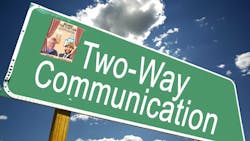Podcast: The Power of Two-Way Communication in Organizational Design
How does information get passed up and down the chain in your organization? Which communication techniques do the best job of keeping everyone well-informed? And are you assuring that communication is a two-way street, giving everyone’s voice a chance to be heard?
Failure to communicate can ruin employee engagement. Robust two-way communication has the opposite effect. In this episode of Behind the Curtain: Adventures in Continuous Improvement, podcast hosts Dr. Mohamed Saleh and John Dyer discuss the positives and negatives of several communication techniques and share insights on tactics that have worked for them.
The hosts begin by reviewing three common communication techniques—monthly messages from leadership, tiered huddles, and newsletters/hall of fame boards/demonstrations—and ultimately focus their attention on tiered huddles. Tiered huddles, Saleh explains, include members from adjoining roles. For example, a Tier One huddle may include team members and their team leader; Tier Two could encompass the team leader and his supervisor, and so on up the chain.
Tier meetings typically have a cadence approach during the course of a day, starting with the frontline employees and then moving up the chain of command.
The cadence is meant to provide a rapid escalation process, Saleh explains. If one of the tiers isn’t able to resolve a problem, it gets escalated to the next level, and “then they have a chance to remove those barriers for you.” Tiered huddles also are a good coaching vehicle, he adds.
The podcast co-hosts also discuss:
- The flatter the organization, the better it is for two-way communication.
- Start huddle meetings by recognizing someone caught in the act of excellence.
- Senior executive attendance at Tier One meetings (closest to the front lines). Dyer says he's seen this done successfully, but only when fear of reprisal has been driven out of an organization.)
- Create an organization that encourages open dialog and blames the process, not the people.
